Identification of Six Emergent Types Based on Cognitive and Affective Constructs that Explain Individuals’ Relationship with the Biosphere
Abstract
1. Introduction
2. The Relationship between Individuals and the Biosphere
Typologies as Ways to Understand Complex Relationships
3. Methods
3.1. Participants and Procedure
3.2. Measures
3.2.1. Intrinsic Construct
3.2.2. Cognitive Construct
3.2.3. Affective Construct
3.2.4. Behavioral Construct
3.2.5. Demographic Descriptive Variables
3.2.6. Confirmatory Descriptive Variables
3.3. Analysis
4. Results
4.1. Six Types Identified
4.2. Type Orientation
4.2.1. The Disconnected
4.2.2. The Uncommitted
4.2.3. The Alarmed
4.2.4. The Believer
4.2.5. The Concerned
4.2.6. The Pleasure-seeker
4.3. Comparing Clustering Variables
4.4. Comparing Profiling Variables
4.4.1. Comparing Behavior
4.4.2. Comparing Values
4.4.3. Comparing Personality
4.5. Comparing Demographic Variables
4.6. Comparing Confirmatory Descriptive Variables
4.7. Similarity and Differences between Types
5. Discussion
6. Conclusions and Limitations
Author Contributions
Funding
Acknowledgments
Conflicts of Interest
References
- IPCC (Intergovernmental Panel on Climate Change). Global Warming of 1.5 Degrees Celsius; IPCC: Geneva, Switzerland, 2018; ISBN 978-92-9169-151-7. Available online: http://www.ipcc.ch/report/sr15/ (accessed on 29 October 2018).
- Fisher, A. Radical Ecopsychology: Psychology in the Service of Life; Suny Press: New York, NY, USA, 2013; ISBN 978-1438444765. [Google Scholar]
- Wynes, S.; Nicholas, K.A. The climate mitigation gap: Education and government recommendations miss the most effective individual actions. Environ. Res. Lett. 2017, 12, 074024. [Google Scholar] [CrossRef]
- Kollmuss, A.; Agyeman, J. Mind the gap: Why do people act environmentally and what are the barriers to pro-environmental behavior? Environ. Educ. Res. 2002, 8, 239–260. [Google Scholar] [CrossRef]
- Baillie, R. Applied Ecopsychology in Australia: Approaches to Facilitating Human-Nature Connections. Gaterings: Seeking Ecopsychology. 8 August 2003. Available online: http://www.ecopsychology.org/journal/gatherings8/html/spirit/applied_baillie.html (accessed on 24 September 2014).
- Beery, T.H.; Wolf-Watz, D. Nature to place: Rethinking the environmental connectedness perspective. J. Environ. Psychol. 2014, 40, 198–205. [Google Scholar] [CrossRef]
- Colding, J.; Giusti, M.; Haga, A.; Wallhager, M.; Barthel, S. Enabling relationships with nature in cities. Sustainability 2020, 12, 4394. [Google Scholar] [CrossRef]
- Vining, J.; Merrick, M.S.; Price, E.A. The distinction between humans and nature: Human perceptions of connectedness to nature and elements of the natural and unnatural. Res. Hum. Ecol. 2008, 15, 1–11. [Google Scholar]
- Doty, D.H.; Glick, W.H. Typologies as a unique form of theory building: Toward improved understanding and modeling. Acad. Manag. Rev. 1994, 19, 230–251. [Google Scholar] [CrossRef]
- Fiss, P.D. Building better causal theories: A fuzzy set approach to typologies in organization research. Acad. Manag. J. 2011, 54, 393–420. [Google Scholar] [CrossRef]
- Mandara, J. The typological approach in child and family psychology: A review of theory, methods, and research. Clin. Child Fam. Psychol. Rev. 2003, 6, 129–146. [Google Scholar] [CrossRef]
- McKelvey, B. Guidelines for the empirical classification of organisations. Adm. Sci. Q. 1975, 20, 509–525. [Google Scholar] [CrossRef]
- Collier, D.; LaPorte, J.; Seawright, J. Putting typologies to work: Concept formation, measurement, and analytic rigor. Political Res. Q. 2012, 65, 217–232. [Google Scholar] [CrossRef]
- Bailey, K.D. Constructing monothetic and polythetic typologies by the heuristic method. Sociol. Q. 1973, 14, 291–308. [Google Scholar] [CrossRef]
- Kluge, S. Empirically grounded construction of types and typologies in qualitative social research. Qual. Soc. Res. 2000, 1, 1–11. Available online: http://nbn-resolving.de/urn:nbn:de:0114-fqs0001145 (accessed on 10 April 2020).
- Leiserowitz, A.; Maibach, E.; Roser-Renouf, C. Global Warmings’ Six Americas 2009: An Audience Segmentation Analysis; Yale Project on Climate Change; Yale University and George Mason University: New Haven, CT, USA, 2009. [Google Scholar]
- Barnes, A.P.; Toma, L. A typology of dairy farmer perceptions towards climate change. Clim. Chang. 2012, 112, 507–522. [Google Scholar] [CrossRef]
- Poortinga, W.; Darnton, A. Segmenting for sustainability: The development of a sustainability segmentation model from a Welsh sample. J. Environ. Psychol. 2016, 45, 221–232. [Google Scholar] [CrossRef]
- Hall, M.P.; Lewis, N.A., Jr.; Ellsworth, P.C. Believing in climate change, but not behaving sustainably: Evidence from a one-year longitudinal study. J. Environ. Psychol. 2018, 56, 55–62. [Google Scholar] [CrossRef]
- Bernstein, J.; Szuster, B. Beyond unidimensionality: Segmenting contemporary pro-environmental worldviews through surveys and repertory grid analysis. Environ. Commun. 2018, 12, 1062–1076. [Google Scholar] [CrossRef]
- Hunka, A.D.; de Groot, W.T.; Biela, A. Visions of nature in Eastern Europe: A Polish example. Environ. Values 2009, 18, 429–452. [Google Scholar] [CrossRef]
- Buijs, A.E.; Fischer, A.; Rink, D.; Young, J.C. Looking beyond superficial knowledge gaps: Understanding public representations of biodiversity. Int. J. Biodivers. Sci. Manag. 2008, 4, 65–80. [Google Scholar] [CrossRef]
- Department for Environment, Food and Rural Affairs (Defra). A Framework for Pro-Environmental Behaviours. 2008. Available online: https://www.gov.uk/government/uploads/system/uploads/attachment_data/file/69277/pb13574-behaviours-report-080110.pdf (accessed on 8 March 2015).
- MacDonald, E.; Harbrow, M.; Jack, S.; Kidd, J.; Wright, A.; Tuinder, P.; Poutasi, M. Segmenting urban populations for greater conservation gains: A new approach targeting cobenefits is required. Conserv. Sci. Pract. 2019, 1, e101. [Google Scholar] [CrossRef]
- Kellert, S.R. American attitudes toward and knowledge of animals: An update. Int. J. Study Anim. Probl. 1980, 1, 87–119. Available online: https://animalstudiesrepository.org/ijsap/vol1/iss2/9 (accessed on 10 April 2020).
- Teel, T.L.; Manfredo, M.J. Understanding the diversity of public interests in wildlife conservation. Conserv. Biol. 2010, 24, 128–139. [Google Scholar] [CrossRef] [PubMed]
- Cini, F.; Leone, L.; Passafaro, P. Promoting ecotourism among young people: A segmentation strategy. Environ. Behav. 2012, 44, 87–106. [Google Scholar] [CrossRef]
- Osherenko, G. Human/nature relations in the Arctic: Changing perspectives. Polar Rec. 1992, 28, 277–284. [Google Scholar] [CrossRef]
- Balderjahn, I.; Peyer, M.; Seegebarth, B.; Wiedmann, K.; Weber, A. The many faces of sustainability-conscious consumers: A category-independent typology. J. Bus. Res. 2018, 91, 83–93. [Google Scholar] [CrossRef]
- Douglas, M.; Wildavsky, A. Risk and Culture; University of California Press: Berkeley, CA, USA; Los Angeles, CA, USA, 1982; ISBN 9780520050631. [Google Scholar]
- Kahn, P.H.; Lourenço, O. Water, air, fire, and earth: A development study in Portugal of environmental moral reasoning. Environ. Behav. 2002, 34, 405–430. [Google Scholar] [CrossRef]
- Lenzen, M.; Sun, Y.; Faturay, F.; Ting, Y.; Geschke, A.; Malik, A. The carbon footprint of global tourism. Nat. Clim. Chang. 2018, 522–528. [Google Scholar] [CrossRef]
- Ndletyana, M. Middle-Class in South Africa: Significance, Role and Impact; BRICS Academic Forum: Rio de Janeiro, Brazil, 2014. [Google Scholar]
- Gifford, R.; Nilsson, A. Personal and social factors that influence pro-environmental concern and behaviour: A review. Int. J. Psychol. 2014, 49, 141–157. [Google Scholar] [CrossRef]
- Corner, A.; Markowitz, E.; Pidgeon, N. Public engagement with climate change: The role of human values. WIREs Clim. Chang. 2014, 5, 411–422. [Google Scholar] [CrossRef]
- Sabini, M.A. CG Jung on Nature, Technology and Modern Life; North Atlantic Books: Berkeley, CA, USA, 2008; ISBN 1556433794. [Google Scholar]
- Schwartz, S.H. An overview of the Schwartz theory of basic values. Online Read. Psychol. Cult. 2012, 2. [Google Scholar] [CrossRef]
- Dunlap, R.E. The New Environmental Paradigm scale: From marginality to worldwide use. J. Environ. Educ. 2008, 40, 3–17. [Google Scholar] [CrossRef]
- Lewis, B.R. Influence of the Dominant Social Paradigm on Consumer Environmental Attitudes, Values and Behaviors. Unpublished Doctoral Thesis, The University of Georgia, Athens, GA, USA, 2009. [Google Scholar]
- Schultz, P.W.; Shriver, C.; Tabanico, J.J.; Khazian, A.M. Implicit connections with nature. J. Environ. Psychol. 2004, 24, 31–42. [Google Scholar] [CrossRef]
- Swim, J.; Clayton, S.; Doherty, T.; Gifford, R.; Howard, G.; Reser, J.; Weber, E. Psychol. and Global Climate Change: Addressing a Multi-Faceted Phenomenon and Set of Challenges. A Report by the American Psychological Association’s Task Force on the Interface between Psychology and Global Climate Change. 2009. Available online: http://www.apa.org/science/about/publications/climate-change.aspx (accessed on 10 April 2020).
- Tauber, P.G. An Exploration of the Relationships among Connectedness to Nature, Quality of Life, and Mental Health (Unpublished Masters Dissertation); Utah State University: Logan, UT, USA, 2012. [Google Scholar]
- World Economic Forum. Global Risks 2014, 9th ed.; World Economic Forum: Geneva, Switzerland, 2014; Available online: www.weforum.org/risks (accessed on 17 February 2015).
- Ojala, A. What Makes Us Environmentally Friendly? Soc. Psychological Studies on Environmental Concern, Components of Morality and Emotional Connectedness to Nature (Unpublished Academic Dissertation); University of Helsinki: Helsinki, Finland, 2012. [Google Scholar]
- Roszak, T. The Voice of the Earth: An Exploration of Ecopsychology; Simon & Schuster: New York, NY, USA, 1992; ISBN 10 1890482803. [Google Scholar]
- Semenya, D.K. The making and prevention of rain amongst the Pedi tribe of South Africa: A pastoral response. HTS Theol. Stud. 2013, 69, 1–5. [Google Scholar] [CrossRef]
- Berndt, A.; Gikonyo, L. Environmental concern behaviours in Africa: An exploratory study. J. Manag. Sustain. 2012, 2, 1. [Google Scholar] [CrossRef][Green Version]
- Herzog, T.; Pershing, J.; Baumert, K.A. Navigating the Numbers: Greenhouse Gas Data and International Climate Policy. World Resources Institute, 2005. Available online: http://www.wri.org/publication/navigating-numbers (accessed on 10 April 2020).
- OECD (Organisation for Economic Co-Operation and Development). Greening Household Behaviour: The Role of Public Policy; OECD Publishing: Paris, France, 2011. [Google Scholar]
- Zarepour, Z. Attitudes and Pro-Environmental Consumption Behaviour: An Application of a Choice Experiment in the Netherlands; International Institute of Social Studies: The Hague, The Netherlands, 2012. [Google Scholar]
- LeBaron, M. Cultural and Worldview Frames. Beyond Intractability; University of Colorado: Boulder, CO, USA, 2003; Available online: http://www.beyondintractability.org/essay/cultural-frames (accessed on 16 September 2015).
- Markowitz, E.M.; Goldberg, L.R.; Ashton, M.C.; Lee, K. Profiling the “pro-environmental individual”: A personality perspective. J. Personal. 2012, 80, 81–111. [Google Scholar] [CrossRef] [PubMed]
- Diamantopoulos, A.; Schlegelmilch, B.B.; Sinkovics, R.R.; Bohlen, G.M. Can socio-demographics still play a role in profiling green consumers? A review of the evidence and an empirical investigation. J. Bus. Res. 2003, 56, 465–480. [Google Scholar] [CrossRef]
- Milfont, T.L.; Sibley, C.G. The big five personality traits and environmental engagement: Associations at the individual and societal level. J. Environ. Psychol. 2012, 32, 187–195. [Google Scholar] [CrossRef]
- Hurst, M.; Dittmar, H.; Bond, R.; Kasser, T. Relationship between materialistic values and environmental attitudes and behaviors: A meta-analysis. J. Environ. Psychol. 2013, 36, 257–269. [Google Scholar] [CrossRef]
- Psytech. Jung Type Indicator: The Technical Manual. 1998. Available online: http://www.psytech.co.za/images/PsytechSA/JTI/JTIMAN.PDF (accessed on 27 January 2015).
- Stern, P.C.; Dietz, T. The value basis of environmental concern. J. Soc. Issues 1994, 50, 65–84. [Google Scholar] [CrossRef]
- Becker, J.; Engelbrecht, A.; Boonzaaier, M.; Finch, J.D.; Meiring, D.; Louw, G. The measurement of values: A psychometric evaluation of the Schwartz Value Survey in the South African context. Manag. Dyn. 2017, 26, 21–41. Available online: http://hdl.handle.net/10520/EJC-a726d5659 (accessed on 10 April 2020).
- Brandimonte, M.A.; Bruno, N.; Collina, S. Cognition. In Psychological Concepts: An International Historical Perspective; Pawlik, P., d’Ydewalle, G., Eds.; Psychology Press: Hove, UK, 2006; pp. 1–22. ISBN 13 978-1841695334. [Google Scholar]
- Nilsson, A. The Psychology of Worldviews: Toward a Non-Reductive Science of Personality; Media-Tryck: Sölvegatan, Sweden, 2013; ISBN 978-91-7473-553-6. [Google Scholar]
- Hergenhahn, B.R. An Introduction to the History of Psychol, 3rd ed.; Brooks/Cole: Pacific Grove, CA, USA, 1997; ISBN 9780534060725. [Google Scholar]
- Dunlap, R.E.; Van Liere, K.D.; Mertig, A.G.; Jones, R.E. Measuring endorsement of the new ecological paradigm: A revised NEP scale. J. Soc. Issues 2000, 56, 425–442. [Google Scholar] [CrossRef]
- Hawcroft, L.J.; Milfont, T.L. The use (and abuse) of the new environmental paradigm scale over the last 30 years: A meta-analysis. J. Environ. Psychol. 2010, 30, 143–158. [Google Scholar] [CrossRef]
- Mayer, F.S.; Frantz, C.M. The connectedness to nature scale: A measure of individuals’ feeling in community with nature. J. Environ. Psychol. 2004, 24, 503–515. [Google Scholar] [CrossRef]
- Rideout, B.E. The liberal arts and environmental awareness: Exploring endorsement of an environmental worldview in college students. Int. J. Environ. Sci. Educ. 2014, 9, 59–76. [Google Scholar] [CrossRef]
- Stern, P.C.; Dietz, T.; Kalof, L. Value orientations, gender, and environmental concern. Environ. Behav. 1993, 25, 322–348. [Google Scholar] [CrossRef]
- Midgley, G. Ecology and the poverty of humanism: A critical systems perspective. Syst. Res. 1994, 11, 67–76. [Google Scholar] [CrossRef]
- Bandura, A. Impeding ecological sustainability through selective moral disengagement. Int. J. Innov. Sustain. Dev. 2007, 2, 8–35. [Google Scholar] [CrossRef]
- Leopold, A. A Sand County Almanac and Other Writings on Ecology and Conservation; Oxford University Press: New York, NY, USA, 1948; ISBN 10 0195007778. [Google Scholar]
- Shuey, H. The fundamental principles of typology. Psychol. Rev. 1937, 1, 170–182. [Google Scholar] [CrossRef]
- Fransson, N.; Gärling, T. Environmental concern: Conceptual definitions, measurement methods, and research findings. J. Environ. Psychol. 1999, 19, 369–382. [Google Scholar] [CrossRef]
- Williams, S.P.; Thondhlana, G.; Kua, H.W. Electricity use behaviour in a high-income neighbourhood in Johannesburg, South Africa. Sustainability 2020, 12, 4571. [Google Scholar] [CrossRef]
- McDonald, J.D. Measuring personality constructs: The advantages and disadvantages of self-reports, informant reports and behavioural assessments. Enquire 2008, 1, 1–19. [Google Scholar]
- Hine, C. Internet research and unobtrusive methods. Soc. Res. Update 2011, 61, 1–4. [Google Scholar]
- StatSoft, Inc. STATISTICA (Data Analysis Software System), Version 12. 2013. Available online: www.statsoft.com (accessed on 10 April 2020).
- Calinski, T.; Harabasz, J. A dendrite method for cluster analysis. Commun. Stat. 1974, 3, 1–27. [Google Scholar] [CrossRef]
- Handgraaf, M.J.J.; Van Lidth de Jeude, M.A.; Appelt, K.C. Public praise vs. private pay: Effects of rewards on energy conservation in the workplace. Ecol. Econ. 2013, 86, 86–92. [Google Scholar] [CrossRef]
- Kwan, V.S.Y.; Naidu, E.S.; Bixter, M.T. Controlling environmental crisis appraisal through knowledge, vividness and timing. J. Environ. Psychol. 2019, 61, 93–100. [Google Scholar] [CrossRef]
- Bullard, R.D.; Johnson, G.S. Environmental justice: Grassroots activism and its impact on public policy decision making. J. Soc. Issues 2000, 56, 555–578. [Google Scholar] [CrossRef]
- Chiro, G.D. Living environmentalism: Coalition politics, social reproduction, and environmental justice. Environ. Politics 2008, 17, 276–298. [Google Scholar] [CrossRef]
- Lertzman, R. Environmental Melancholia: Psychoanalytic Dimensions of Engagement; Routledge: London, UK, 2015; ISBN 10 9780415727990. [Google Scholar]
- Zheng, Y.; Yoshino, R. Diversity patterns of attitudes toward nature and environment in Japan, USA, and European nations. Behaviormetrika 2003, 30, 21–37. [Google Scholar] [CrossRef]
- Pike, C.; Herr, M.; Minkow, D.; Weiner, H. The Ecological Roadmap: A Guide to American Social Values and Environmental Engagement; Earthjustice: San Francisco, CA, USA, 2008; pp. 1–25. Available online: https://climateaccess.org/system/files/ReGreen%20The%20Ecological%20Roadmap.pdf (accessed on 26 August 2020).
- Bauer, N.; Wallner, A.; Hunziker, M. The change of European landscapes: Human-nature relationships, public attitudes towards rewilding, and the implications for landscape management in Switzerland. J. Environ. Manag. 2009, 90, 2910–2920. [Google Scholar] [CrossRef]
- Dwyer, W.O.; Leeming, F.C. Critical review of behavioral interventions to preserve the environment. Environ. Behav. 1993, 25, 275–321. [Google Scholar] [CrossRef]
- Cohen, M.J. Reconnecting with Nature: Finding Wellness through Restoring Your Bond with the Earth; Ecopress: Minnesota, MN, USA, 2007; ISBN 13 978-0963970527. [Google Scholar]
- Bendell, J. Deep Adaptation: A Map for Navigating Climate Tragedy (IFLAS Occasional Paper). 2018. Available online: https://www.lifeworth.com/deepadaptation.pdf (accessed on 10 April 2020).
- Lee, J.A.; Holden, S.S. Understanding determinants of environ-mentally conscious behavior. Psychol. Mark. 1999, 16, 373–392. [Google Scholar] [CrossRef]
- Kahn, M.E.; Morris, E.A. Walking the walk: The association between community environmentalism and green travel behavior. J. Am. Plan. Assoc. 2009, 75, 389–405. [Google Scholar] [CrossRef]
- Stern, P.C.; Dietz, T.; Abel, T.D.; Guagnano, G.; Kalof, L. A Value-Belief-Norm Theory of Support for Social Movements: The Case of Environmentalism. Huxley College on the Peninsulas. 1999. Available online: https://cedar.wwu.edu/hcop_facpubs/1 (accessed on 15 February 2020).
- Fischer, A.; Young, J.C. Understanding mental constructs of biodiversity: Implications for biodiversity management and conservation. Biol. Conserv. 2007, 136, 271–282. [Google Scholar] [CrossRef]
- Jordan, M. Nature and Therapy: Understanding Counseling and Psychotherapy in Outdoor Spaces; Routledge: London, UK, 2015; ISBN 9780415854610. [Google Scholar]
- Atkins, S.; Snyder, M. Nature-Based Expressive Arts Therapy: Integrating the Expressive Arts and Ecotherapy; Jessica Kingsley Publishers: London, UK, 2018; ISBN 13 978-1785927263. [Google Scholar]
- Macy, J.; Brown, M. Coming Back to Life; New Society Publishers: Gabriola Island, BC, Canada, 2014; ISBN 10 0865717753. [Google Scholar]
- Steg, L.; Vlek, C. Encouring pro-environmental behaviour: An integrative review and research agenda. J. Environ. Psychol. 2009, 29, 309–317. [Google Scholar] [CrossRef]
- Axon, S. “Keeping the ball rolling”: Addressing the enablers of, and barriers to, sustainable lifestyles. J. Environ. Psychol. 2017, 52, 11–25. [Google Scholar] [CrossRef]
- Glaeser, E.L. The supply of environmentalism: Psychological interventions and economics. Rev. Environ. Econ. Policy 2014, 8, 208–229. [Google Scholar] [CrossRef]
- Soper, K. Re-thinking the ‘good life’: The citizenship dimension of consumer disaffection with consumerism. J. Consum. Cult. 2007, 7, 205–229. [Google Scholar] [CrossRef]
- Andrews, N.; Hoggett, P. Facing up to Ecological Crisis: A Psycho Social Perspective from Climate Psychology. In Facing Up to Climate Reality: Honesty, Disaster and Hope (Chapter 8); Foster, J., Ed.; Publishing Partnership: London, UK, 2019; ISBN 9781907994944. [Google Scholar]
- Berghöfer, U.; Rozzi, R.; Jax, K. Local versus global knowledge: Diverse perspectives on nature in the Cape Horn biosphere reserve. Environ. Ethics 2008, 30, 273–294. [Google Scholar] [CrossRef]
- Elgaaied, L. Exploring the role of anticipated guilt on pro-environmental behavior: A suggested typology of residents in France based on their recycling patterns. J. Consum. Mark. 2012, 29, 369–377. [Google Scholar] [CrossRef]
- Sigmund, K. John Maynard Smith and Evolutionary Game Theory; IIASA Interim Report; IIASA: Laxenburg, Austria, 2005; IR 05-076 2005. [Google Scholar]
- Neicu, D. Psychological game theory: A review of current literature. Rev. Bus. Econ. Lit. 2012, 57, 37–60. [Google Scholar]
- Booysen, M.J.; Visser, M.; Burger, R. Temporal case study of household behavioural response to Cape Town’s “Day Zero” using smart meter data. Water Res. 2019, 149, 414–420. [Google Scholar] [CrossRef]
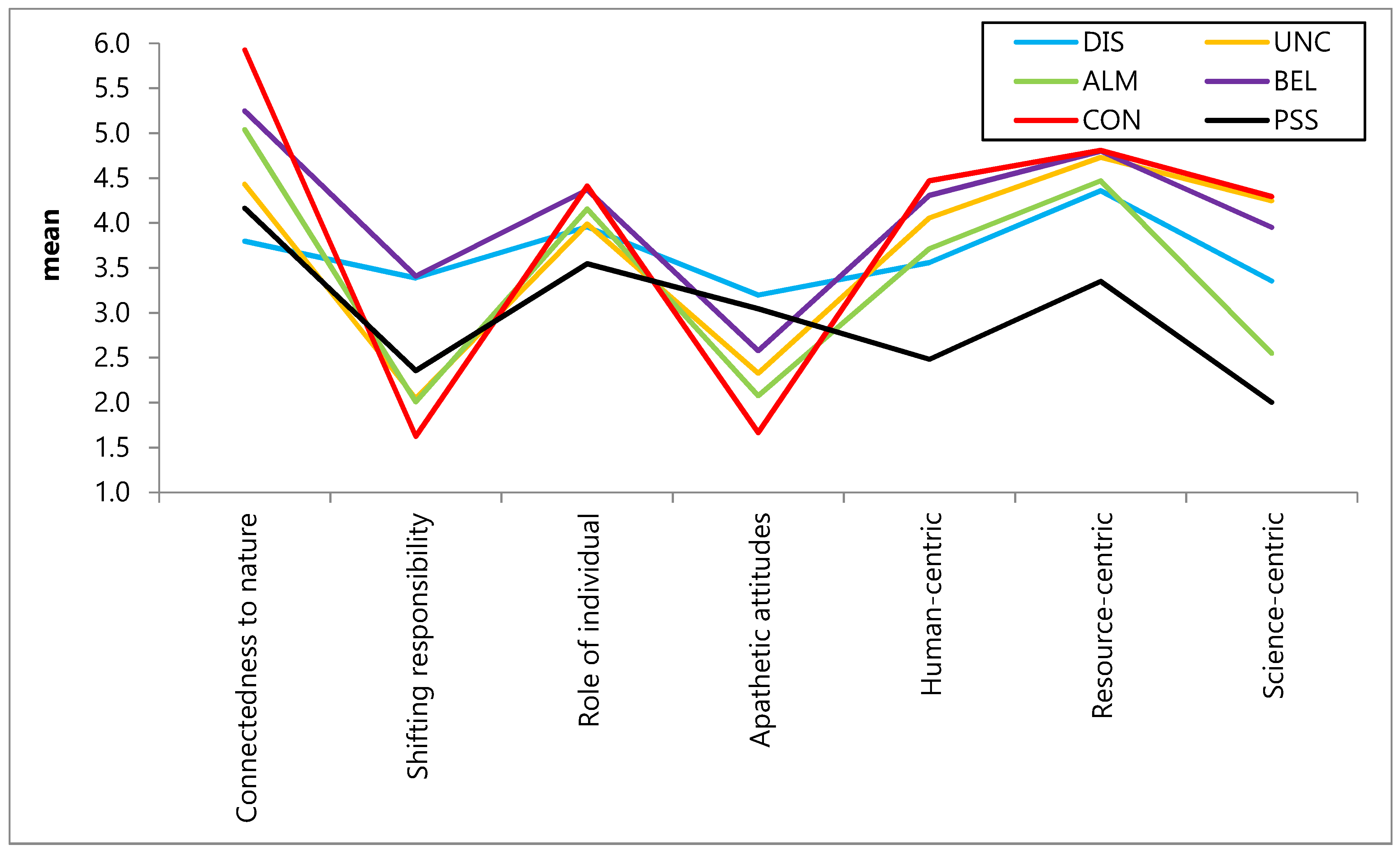
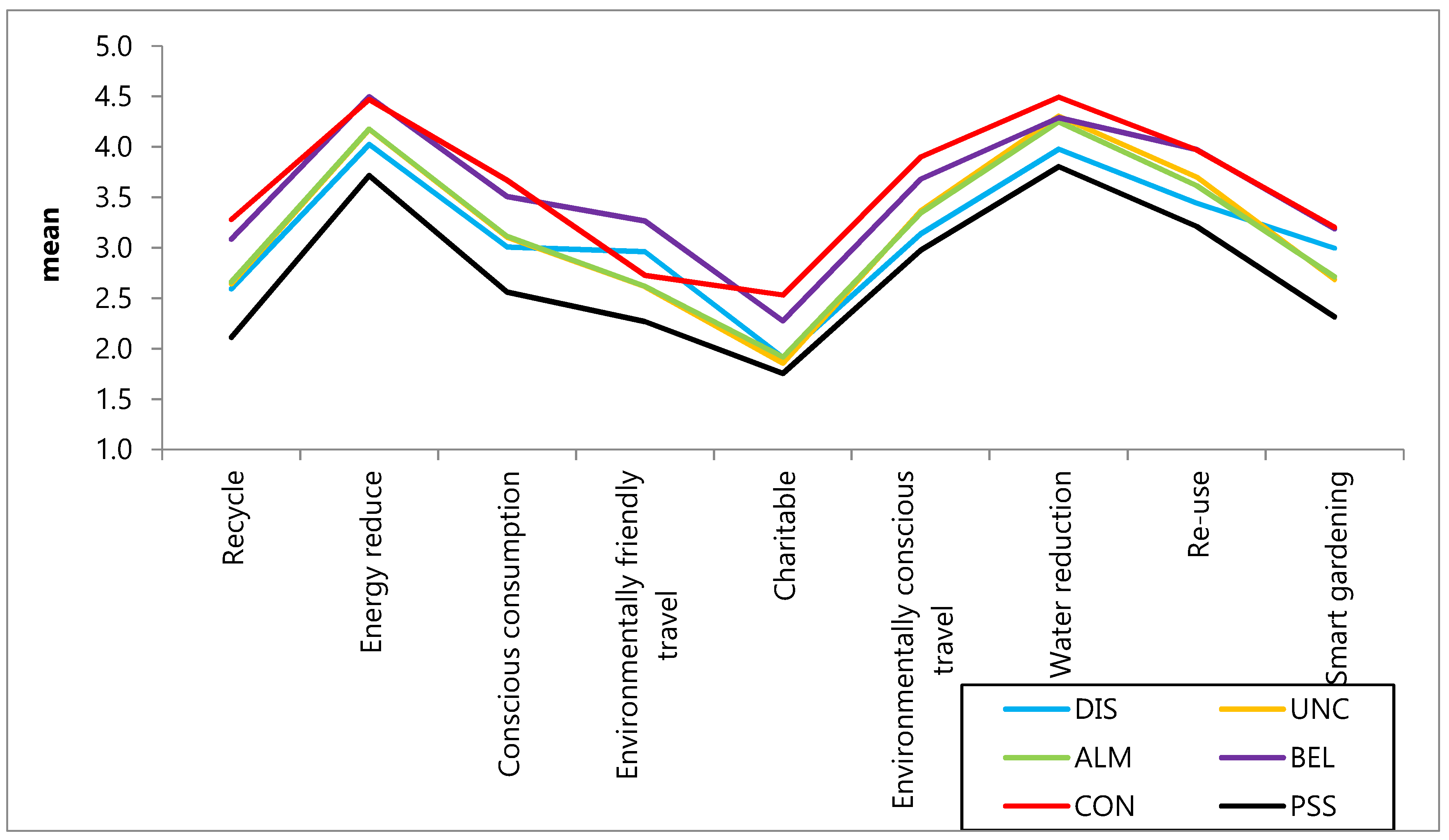
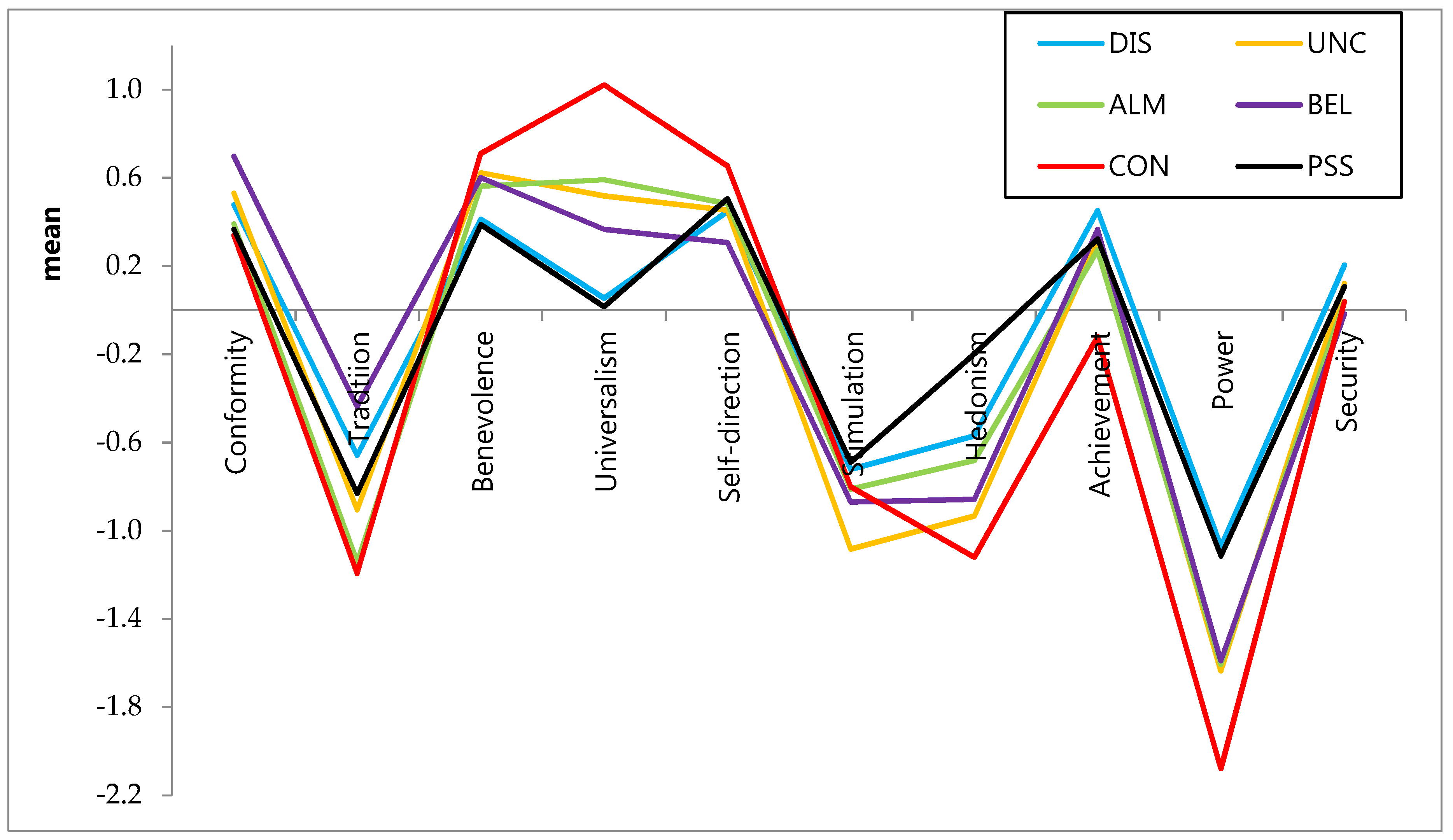
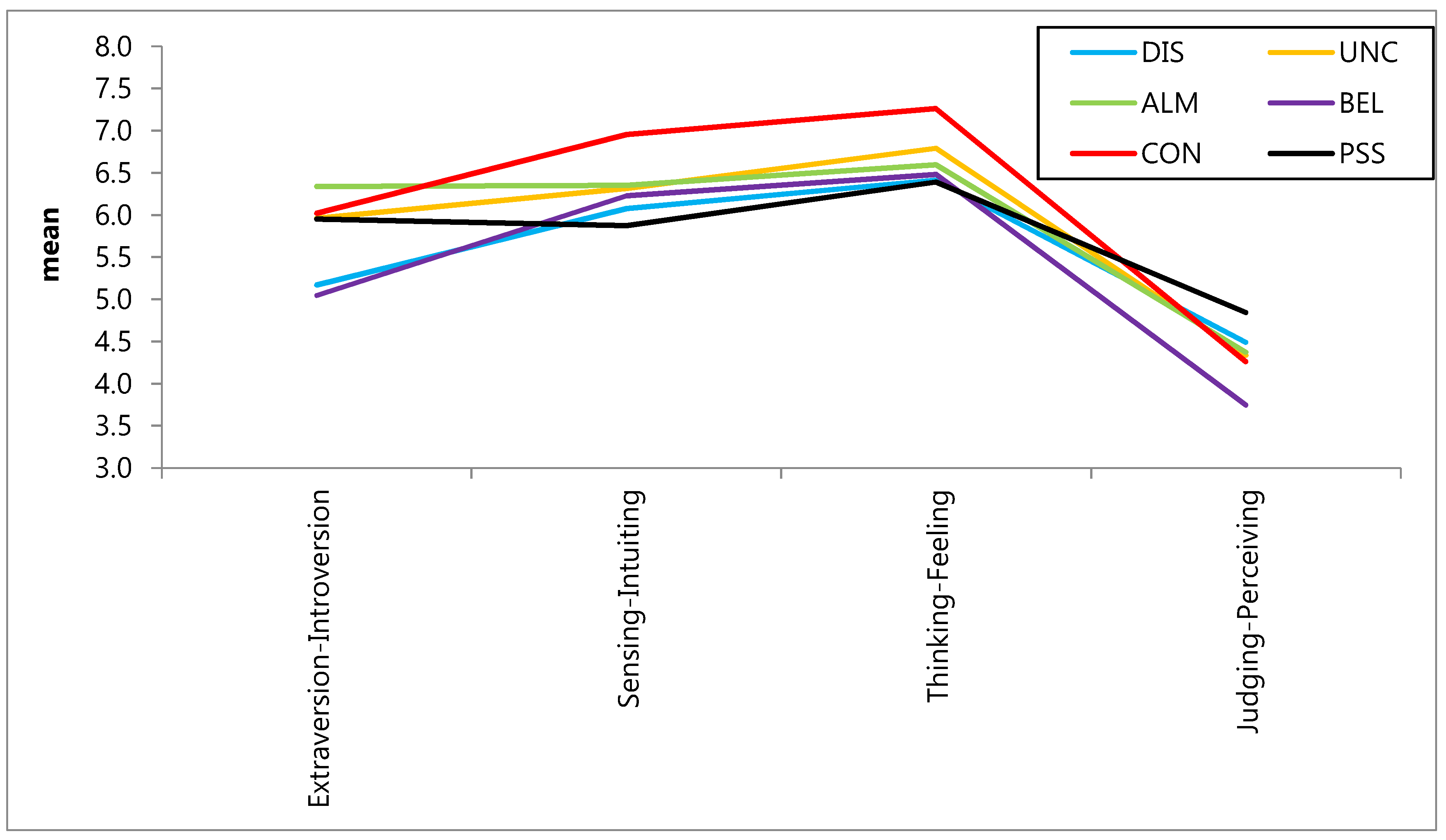

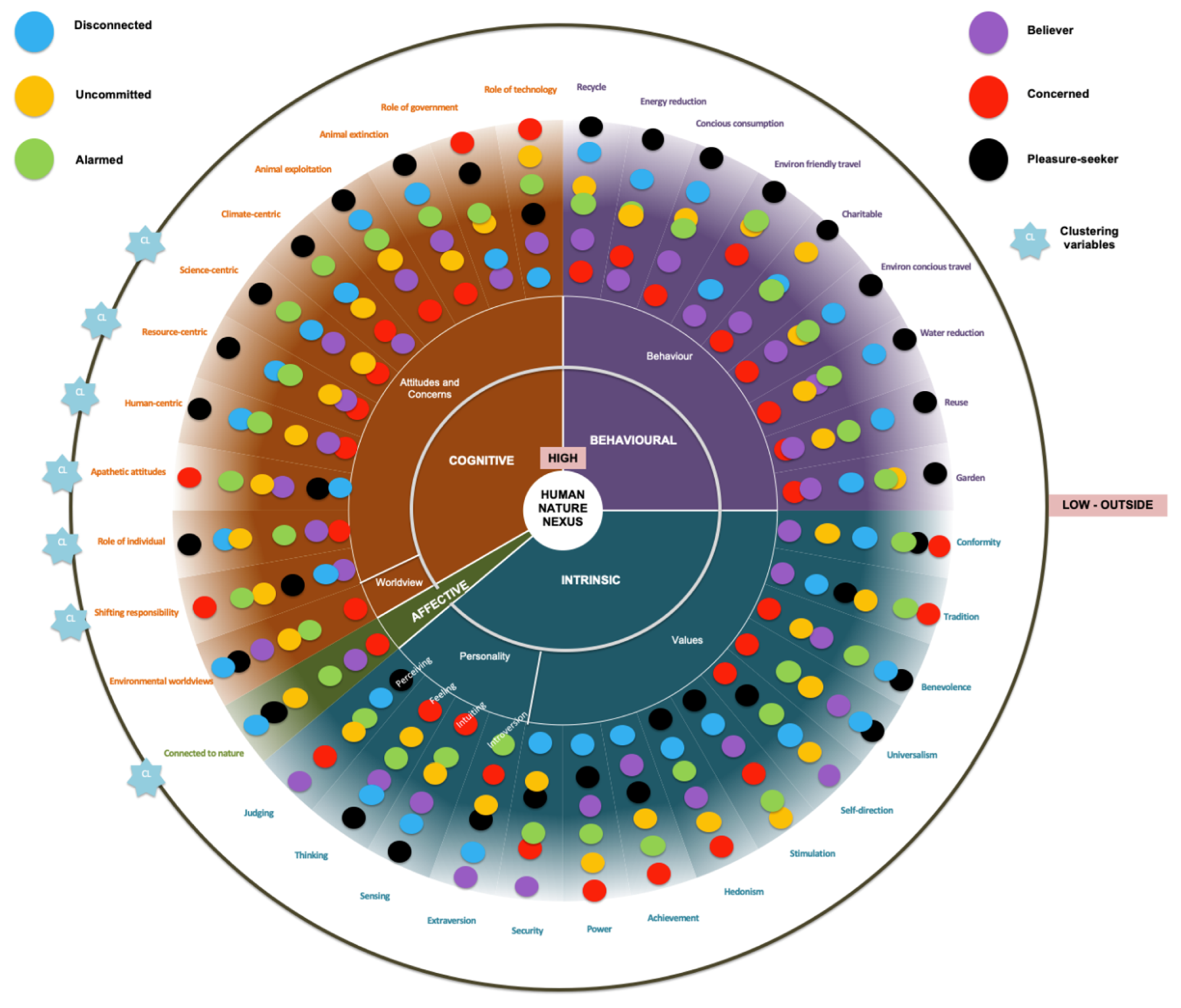
| Clustering Variables | DIS | UNC | ALM | BEL | CON | PSS | Df/F-stat | η2 | Significant Differences between Types |
|---|---|---|---|---|---|---|---|---|---|
| N = 75 | N = 120 | N = 176 | N = 104 | N = 170 | N = 170 | ||||
| Connectedness to nature | 3.80 | 4.43 | 5.04 | 5.25 | 5.93 | 4.16 | F(5721) = 190.5 * | 0.57 | CON > ALM, BEL > UNC, PSS > DIS |
| (0.68) | (0.66) | (0.59) | (0.50) | (0.52) | (0.77) | ||||
| Shifting responsibility | 3.39 | 2.05 | 2.01 | 3.41 | 1.62 | 2.36 | F(5721) = 212.57 * | 0.60 | DIS, BEL > PSS > UNC, ALM > CON |
| (0.60) | (0.47) | (0.56) | (0.63) | (0.46) | (0.60) | ||||
| Role of individual | 3.95 | 3.99 | 4.16 | 4.37 | 4.41 | 3.55 | F(5721) = 32.39 * | 0.18 | CON > ALM, UNC, DIS > PSS; BEL > UNC, DIS > PSS |
| (0.57) | (0.50) | (0.56) | (0.57) | (0.53) | (0.69) | ||||
| Apathetic attitudes | 3.20 | 2.33 | 2.07 | 2.58 | 1.67 | 3.04 | F(5721) = 98.78 * | 0.41 | DIS, PSS > BEL > UNC > ALM > CON |
| (0.72) | (0.60) | (0.58) | (0.74) | (0.49) | (0.67) | ||||
| Human-centric | 3.56 | 4.06 | 3.71 | 4.31 | 4.47 | 2.48 | F(5721) = 149.63 * | 0.51 | BEL, CON > UNC > DIS, ALM > PSS |
| (0.60) | (0.65) | (0.60) | (0.48) | (0.45) | (0.67) | ||||
| Resource-centric | 4.36 | 4.73 | 4.47 | 4.80 | 4.81 | 3.35 | F(5721) = 123.62 * | 0.46 | BEL, CON, UNC > ALM, DIS > PSS |
| (0.54) | (0.34) | (0.46) | (0.28) | (0.32) | (0.89) | ||||
| Science-centric | 3.36 | 4.25 | 2.55 | 3.95 | 4.29 | 2.00 | F(5721) = 281.86 * | 0.66 | UNC, CON > BEL > DIS > ALM > PSS |
| (0.60) | (0.52) | (0.63) | (0.60) | (0.58) | (0.75) |
| Behavioral Variables | DIS | UNC | ALM | BEL | CON | PSS | Df/F-stat | η2 | Significant Differences between Types |
|---|---|---|---|---|---|---|---|---|---|
| N = 75 | N = 120 | N = 176 | N 104 | N = 170 | N = 170 | ||||
| Recycle | 2.59 | 2.64 | 2.66 | 3.08 | 3.28 | 2.11 | F(5714) = 17.71 * | 0.11 | CON, BEL > ALM, UNC, DIS, PSS; ALM, UNC > PSS |
| (1.02) | (0.96) | (0.99) | (1.18) | (1.09) | (0.89) | ||||
| Energy reduce | 4.03 | 4.18 | 4.18 | 4.50 | 4.47 | 3.72 | F(5714) = 21.44 * | 0.13 | BEL, CON > DIS, UNC, ALM > PSS |
| (0.79) | (0.67) | (0.59) | (0.55) | (0.50) | (0.77) | ||||
| Conscious consumption | 3.01 | 3.11 | 3.12 | 3.51 | 3.67 | 2.56 | F(5714) = 32.46 * | 0.19 | BEL, CON > DIS, UNC, ALM > PSS |
| (0.87) | (0.67) | (0.66) | (0.77) | (0.66) | (0.76) | ||||
| Environmentally friendly travel | 2.96 | 2.62 | 2.62 | 3.27 | 2.73 | 2.27 | F(5714) = 9.79 * | 0.06 | BEL > CON, UNC, ALM, PSS; DIS > PSS |
| (1.03) | (0.98) | (1.00) | (1.10) | (1.13) | (1.01) | ||||
| Charitable | 1.91 | 1.86 | 1.92 | 2.27 | 2.53 | 1.75 | F(5714) = 11.79 * | 0.08 | CON > ALM, DIS, UNC, PSS; BEL > UNC, PSS |
| (1.13) | (0.90) | (0.90) | (1.12) | (1.05) | (0.94) | ||||
| Environmentally conscious travel | 3.14 | 3.37 | 3.35 | 3.68 | 3.90 | 2.98 | F(5714) = 14.23 * | 0.09 | CON > UNC, ALM, DIS, PSS; BEL > DIS, PSS |
| (1.02) | (0.96) | (0.96) | (1.00) | (0.89) | (1.07) | ||||
| Water reduction | 3.98 | 4.31 | 4.25 | 4.29 | 4.49 | 3.80 | F(5714) = 10.82 * | 0.07 | CON > ALM, DIS, PSS; UNC, BEL, ALM > PSS |
| (0.91) | (0.67) | (0.72) | (0.74) | (0.65) | (1.05) | ||||
| Re-use | 3.44 | 3.70 | 3.62 | 3.97 | 3.97 | 3.21 | F(5714) = 10.01 * | 0.07 | CON > ALM, DIS, PSS; BEL > DIS, PSS; UNC > PSS |
| (1.00) | (0.85) | (0.96) | (1.03) | (0.86) | (1.05) | ||||
| Smart gardening | 3.00 | 2.69 | 2.71 | 3.19 | 3.20 | 2.31 | F(5714) = 10.58 * | 0.07 | BEL, CON > ALM, UNC, PSS; DIS > PSS |
| (1.05) | (1.11) | (1.09) | (1.14) | (1.01) | (1.14) |
| Value Variables | DIS | UNC | ALM | BEL | CON | PSS | Df/F-stat | η2 | Significant Differences between Types |
|---|---|---|---|---|---|---|---|---|---|
| N = 75 | N = 120 | N = 176 | N = 104 | N = 170 | N = 170 | ||||
| Conformity | 0.48 | 0.53 | 0.39 | 0.70 | 0.34 | 0.37 | F(5648) = 2.46 | 0.02 | NONE |
| (0.86) | (0.78) | (0.91) | (0.80) | (0.83) | (0.85) | ||||
| Tradition | −0.66 | −0.90 | −1.14 | −0.44 | −1.19 | −0.83 | F(5648) = 7.90 ** | 0.06 | BEL > UNC, ALM, CON; DIS > CON |
| (0.93) | (1.14) | (1.02) | (0.86) | (1.13) | (1.13) | ||||
| Benevolence | 0.41 | 0.62 | 0.56 | 0.60 | 0.71 | 0.39 | F(5648) = 2.78 * | 0.02 | NONE |
| (0.66) | (0.68) | (0.79) | (0.77) | (0.64) | (0.86) | ||||
| Universalism | 0.05 | 0.52 | 0.59 | 0.37 | 1.02 | 0.02 | F(5648) = 37.97 ** | 0.23 | CON > ALM, UNC, BEL, DIS, PSS; ALM, UNC > DIS, PSS; BEL > PSS |
| (0.58) | (0.63) | (0.61) | (0.62) | (0.63) | (0.67) | ||||
| Self-direction | 0.45 | 0.45 | 0.48 | 0.31 | 0.65 | 0.51 | F(5648) = 2.48 | 0.02 | NONE |
| (0.62) | (0.71) | (0.80) | (0.63) | (0.82) | (0.84) | ||||
| Stimulation | −0.72 | −1.08 | −0.81 | −0.87 | −0.80 | −0.69 | F(5648) = 1.50 | 0.01 | NONE |
| (1.18) | (1.04) | (1.10) | (1.14) | (1.16) | (1.11) | ||||
| Hedonism | −0.57 | −0.93 | −0.68 | −0.86 | −1.12 | −0.20 | F(5648) = 7.89 ** | 0.06 | PSS > BEL, UNC, CON; ALM > CON |
| (1.07) | (1.19) | (1.05) | (1.07) | (1.19) | (1.17) | ||||
| Achievement | 0.45 | 0.31 | 0.27 | 0.37 | −0.12 | 0.32 | F(5648) = 7.48 ** | 0.05 | DIS, UNC, ALM, BEL, PSS > CON |
| (0.78) | (0.71) | (0.85) | (0.75) | (0.92) | (0.78) | ||||
| Power | −1.07 | −1.64 | −1.61 | −1.59 | −2.08 | −1.12 | F(5648) = 18.47 ** | 0.12 | DIS, PSS > UNC, ALM, BEL > CON |
| (0.92) | (0.77) | (0.87) | (0.98) | (0.85) | (0.90) | ||||
| Security | 0.20 | 0.12 | 0.04 | −0.02 | 0.04 | 0.11 | F(5648) = 0.78 | 0.01 | NONE |
| (0.67) | (0.77) | (0.82) | (0.82) | (0.81) | (0.79) |
| Personality Variables | DIS | UNC | ALM | BEL | CON | PSS | Df/F-stat | η2 | Significant Differences between Types |
|---|---|---|---|---|---|---|---|---|---|
| N = 75 | N = 120 | N = 176 | N = 104 | N = 170 | N = 170 | ||||
| Extraversion–Introversion | 5.17 | 5.96 | 6.34 | 5.05 | 6.02 | 5.95 | F(5613) = 6.95 ** | 0.05 | ALM > DIS, BEL; CON, UNC > BEL |
| (1.72) | (1.87) | (2.04) | (1.61) | (1.97) | (2.03) | ||||
| Sensing–Intuiting | 6.08 | 6.32 | 6.35 | 6.23 | 6.95 | 5.88 | F(5613) = 7.64 ** | 0.06 | CON > DIS, UNC, ALM, BEL, PSS |
| (1.04) | (1.36) | (1.54) | (1.15) | (1.48) | (1.53) | ||||
| Thinking–Feeling | 6.42 | 6.79 | 6.59 | 6.48 | 7.26 | 6.39 | F(5613) = 7.66 ** | 0.06 | CON > DIS, ALM, BEL, PSS |
| (1.24) | (1.19) | (1.51) | (1.10) | (1.29) | (1.32) | ||||
| Judging–Perceiving | 4.49 | 4.34 | 4.37 | 3.75 | 4.26 | 4.84 | F(5613) = 3.93 * | 0.03 | PSS > BEL |
| (1.32) | (1.48) | (1.58) | (1.22) | (1.76) | (1.73) |
| Profiling Variables | DIS | UNC | ALM | BEL | CON | PSS | Df/F-stat | η2 | Significant Differences between Types |
|---|---|---|---|---|---|---|---|---|---|
| N = 75 | N = 120 | N = 176 | N = 104 | N = 170 | N = 170 | ||||
| Environmental worldviews | 3.21 | 3.70 | 3.74 | 3.54 | 4.11 | 3.39 | F(5714) = 44.86 * | 0.24 | CON > ALM, UNC, BEL, PSS, DIS; ALM > BEL, PSS, DIS; UNC > PSS, DIS; BEL > DIS |
| (0.40) | (0.45) | (0.54) | (0.46) | (0.53) | (0.55) | ||||
| Climate-centric | 3.73 | 3.92 | 3.49 | 4.25 | 4.15 | 2.50 | F(5721) = 60.74 * | 0.30 | BEL > UNC, DIS, ALM, PSS; CON > DIS, ALM, PSS; UNC > ALM, PSS; DIS, UNC > PSS |
| (0.71) | (0.87) | (0.80) | (0.75) | (0.72) | (0.87) | ||||
| Animal exploitation | 3.21 | 3.66 | 3.40 | 3.81 | 4.26 | 2.75 | F(5667) = 41.73 * | 0.24 | CON > BEL, UNC, ALM, DIS, PSS; BEL > ALM, DIS > PSS; UNC > DIS > PSS |
| (1.04) | (0.81) | (0.82) | (0.86) | (0.58) | (0.95) | ||||
| Animal extinction | 3.42 | 4.25 | 4.01 | 4.19 | 4.65 | 3.18 | F(5667) = 46.94 * | 0.26 | CON > UNC, ALM, BEL > DIS, PSS |
| (1.04) | (0.81) | (0.72) | (0.80) | (0.48) | (1.01) | ||||
| Role of government | 3.73 | 3.36 | 3.35 | 3.83 | 3.22 | 3.41 | F(5721) = 7.713 * | 0.05 | BEL > PSS, UNC, ALM, CON DIS > CON |
| (0.72) | (0.90) | (0.90) | (0.85) | (1.09) | (0.83) | ||||
| Role of technology | 3.39 | 2.48 | 2.72 | 3.25 | 2.36 | 2.86 | F(5721) = 34.478 * | 0.19 | DIS, BEL > PSS, ALM, UNC, CON; PSS > UNC, CON; ALM > CON |
| (0.77) | (0.65) | (0.70) | (0.80) | (0.80) | (0.63) |
© 2020 by the authors. Licensee MDPI, Basel, Switzerland. This article is an open access article distributed under the terms and conditions of the Creative Commons Attribution (CC BY) license (http://creativecommons.org/licenses/by/4.0/).
Share and Cite
Marais-Potgieter, A.; Thatcher, A. Identification of Six Emergent Types Based on Cognitive and Affective Constructs that Explain Individuals’ Relationship with the Biosphere. Sustainability 2020, 12, 7614. https://doi.org/10.3390/su12187614
Marais-Potgieter A, Thatcher A. Identification of Six Emergent Types Based on Cognitive and Affective Constructs that Explain Individuals’ Relationship with the Biosphere. Sustainability. 2020; 12(18):7614. https://doi.org/10.3390/su12187614
Chicago/Turabian StyleMarais-Potgieter, Andrea, and Andrew Thatcher. 2020. "Identification of Six Emergent Types Based on Cognitive and Affective Constructs that Explain Individuals’ Relationship with the Biosphere" Sustainability 12, no. 18: 7614. https://doi.org/10.3390/su12187614
APA StyleMarais-Potgieter, A., & Thatcher, A. (2020). Identification of Six Emergent Types Based on Cognitive and Affective Constructs that Explain Individuals’ Relationship with the Biosphere. Sustainability, 12(18), 7614. https://doi.org/10.3390/su12187614






